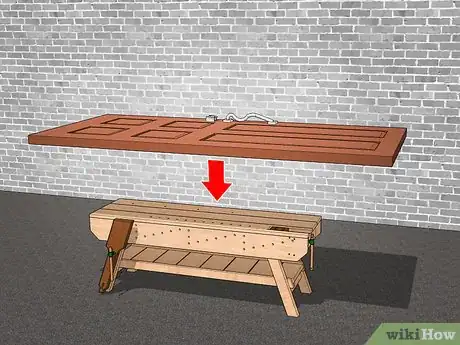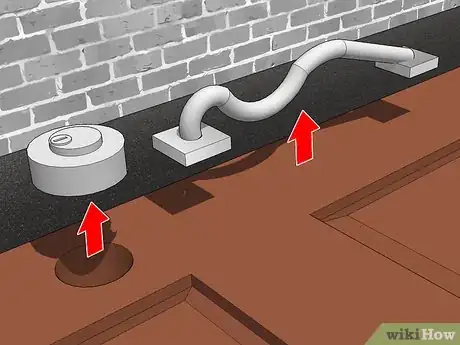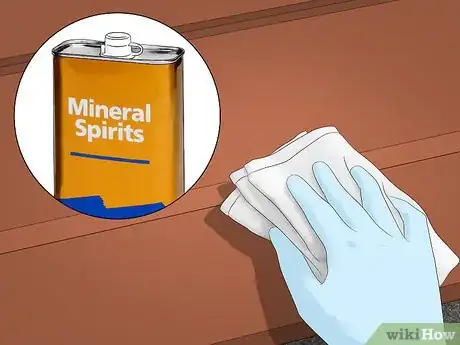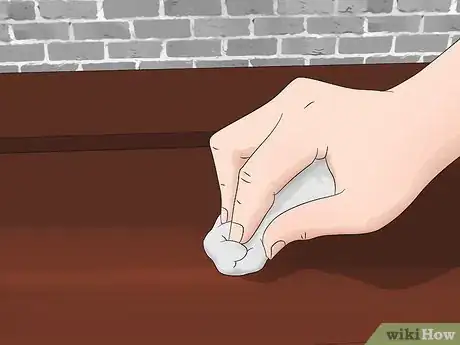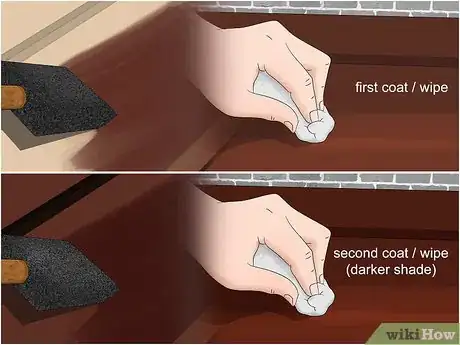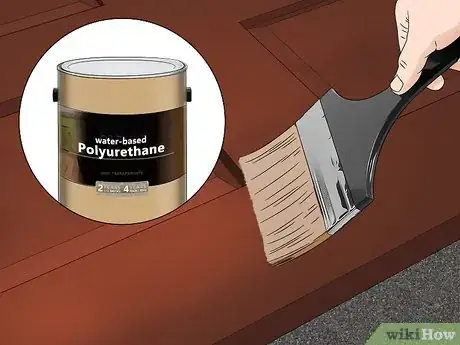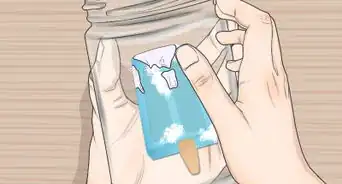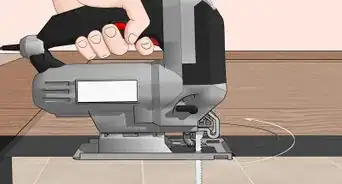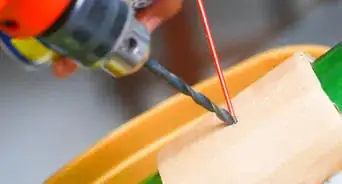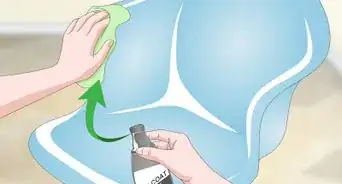This article was co-authored by wikiHow Staff. Our trained team of editors and researchers validate articles for accuracy and comprehensiveness. wikiHow's Content Management Team carefully monitors the work from our editorial staff to ensure that each article is backed by trusted research and meets our high quality standards.
There are 12 references cited in this article, which can be found at the bottom of the page.
This article has been viewed 24,867 times.
Learn more...
Staining a fiberglass door is a simple project that can add a splash of inviting color to any entryway. Whether you want to add a fun pop of color to your exterior door or stain an interior door to look like wood, we can help. Our guide will walk you through all the steps, from prepping the door to painting it with the gel stain, so read on to get started!
Steps
Removing and Stripping the Door
-
1Take the door off its hinges. Open the door enough to provide access to the hinges. Use a hammer to tap the hinge pin out from the bottom and set it aside. Lift the door until it clears the hinges, then lower it to the floor carefully.[1]
- If you're having trouble removing the door on your own, it may help to have someone else extract the hinge pin while you guide it off the hinges or vice-versa.
- It may be easier to stain sliding and swinging doors while they're still mounted due to the inconvenience of taking them down.
-
2Place the door on an elevated surface. Lay the door on a level workbench or craft table, or situate it between two sawhorses. Doing your staining on a higher surface will spare your knees and back the discomfort of bending or stooping for long periods of time.[2]
- If possible, set up your work area outdoors or in a well-ventilated garage or similar space to keep the fumes from the stain from becoming overpowering.
Advertisement -
3Remove all hardware from the door. Disassemble the knob or handle, hinge plates, latches, locks, and any other fixtures that might get in the way while you're staining. The idea is to strip the door down to a single piece so you can work quickly and efficiently.[3]
- Most door hardware can easily be removed using a screwdriver, but other tools like an adjustable wrench, pliers, and a hammer may also come in handy.
- Temporarily store screws and other small pieces in labelled bags or jars to avoid losing them.
-
4Wipe down the door with mineral spirits. Soak up a small amount of mineral spirits with a clean cloth or sponge and scrub the entire surface of the door from top to bottom to prepare it to accept the new finish. Pay particular attention to areas showing signs of heavy buildup or discoloration. Allow the door to dry completely before moving on to applying the stain—this should only take 2-3 minutes.[4]
- A thorough wipedown will lift away any lingering dirt, dust, or grime that might prevent the new coat of stain from adhering.
- You can also use a basic all-purpose cleaner if you don't have any mineral spirits handy.[5]
-
5Strip the existing finish from an old door. If you're renewing a door that's been stained previously, it will be necessary to first get rid of the old finish. You can do this by slathering it with a thin coat of chemical solvent, which will slowly liquefy the dried stain. Let the solvent sit for 3-5 minutes, then wipe away all traces of chemical residue using a disposable rag.[6]
- Chemical solvents give off harmful fumes, so be sure to wear a respirator or facemask and work in a well-ventilated area to minimize your exposure.[7]
- Not all solvents are safe to use on fiberglass surfaces. Before you begin stripping the door, check the manufacturer's guidelines by visiting their website or calling their customer service line to find out which products they recommend.
Applying the Stain
-
1Select a gel stain in the desired color. Unlike wood and other materials, fiberglass surfaces should always be stained with oil-based gel products. Gel stains are thicker and creamier than other types of stains, which makes them better able to adhere to smooth synthetic materials and gives them a bold, uniform appearance.[8]
- Look for gel stains in the pain aisle of your local home improvement center or hardware store.
- Gel stains are available in a variety of shades. This will allow you to simulate the look of different types of wood.
-
2Apply a liberal amount of stain to the inner panels of the door. Slather on the stain using a 2 in (5.1 cm) foam brush. Start with the raised and recessed sections at the center of the door. Be sure to work the stain deep into the imitation grain pattern or any other textural detailing.[9]
- Always wear gloves when working with staining products. Not only will they keep your hands clean, they'll also keep you from transferring the oils on your skin to the door.
- Stir the stain thoroughly before you begin to ensure that it goes on with a consistent texture.
-
3Remove excess stain using a clean rag. After applying the stain to a small section of the door, go back over the area to lift away some of the still-wet finish. You'll notice the color gradually becoming lighter. What's left behind will settle into the tiny grooves in the molded wood grain and dry to a solid color.[10]
- Some painters prefer to make an additional pass with a clean brush to pick up excess stain rather than using a separate rag.[11]
-
4Continue brushing and wiping until you achieve the desired shade. The finish will take on a slightly darker tone with each application. It may take several coats before you get your door looking the way you want it.
- For the most consistent finish, stain the entire door and apply follow-up coats as needed rather than concentrating on a single section at a time.
- Most gel stain manufacturers recommended using a total of no more than 2 or 3 coats. Applying the stain too thick may hinder its ability to dry fully.
-
5Work your way to the outer portions of the door. When you're done staining the interior panels, move on to the outlying areas, including the surrounding grooves and the flat sections at the top, bottom, and sides. Save the outermost edges of the door (the parts that rest against the jamb when closed) for last.[12]
- Use a separate soft-bristled brush to erase contrasting streaks or lap lines between the inner and outer sections of the door while the stain is still wet.
-
6Let the stain dry for 12-24 hours. Most gel stains take about half a day to dry completely. However, exact drying times will vary depending on the amount of stain you use, the size of the door being finished, and specific environmental conditions.
- Perform a touch test on an inconspicuous part of the door sometime after the first 24 hours. If it feels tacky, it needs a little longer.
- Don't forget to stain the opposite side of the door once the first side is dry.
Protecting the New Finish
-
1Apply a final protective clear coat. Once the door is completely dry, brush on a layer of liquid polyurethane or a similar water-based sealant. Apply the clear coat the same way you did the stain, starting with the inside panels and working your way out, finishing with the edges.[13]
- The clear coat will seal in the fresh stain, preserving its rich color and protecting it from dust, dirt, and damage.
- If you're staining an exterior door, select an outdoor varnish that will hold up to regular exposure to sunlight, precipitation, and extreme temperatures.[14]
- As you did when stripping and staining the door, pull on a pair of gloves and make sure you're wearing a respirator or facemask or working in a well-ventilated space to avoid inhaling harmful fumes.
-
2Allow the clear coat to dry for 8 to 24 hours. It's a good idea to leave the door to dry overnight, just to be on the safe side. In the meantime, avoid handling the wet sealant, as this can leave behind smudges. If you want to touch-test the clear coat, do it on one of the outer edges of the door where imperfections will be less visible.[15]
- If possible, keep the door in a dust-free setting while it dries to prevent drifting particles from sticking in the clear coat.
- Since you'll have to stain and seal the door one side at a time, the entire finishing process may take up to 4-5 days.
-
3Replace the door's hardware. Reattach all loose knobs, hinges, latches, and locks. These can simply be put back where they go and screwed down. Take a few minutes to confirm that each piece is oriented correctly and every last screw is nice and tight. Your door will now be ready to re-hang.
- This can be a good opportunity to upgrade your fixtures, if you're planning renovating the entire door. Shop around for pieces that match the particular tint of the stain you used.
-
4Hang the door back up. Line up the hinge halves on the door with those on the wall and fit them together before reinserting the hinge pins. Open and close the door a few times to make sure it tracks smoothly. Then, stand back and admire the new and improved look of your door![16]
Warnings
- It's possible for environmental conditions like high humidity and poor airflow to interfere with drying stains. If the stain hasn't dried within about 5 days, you'll often have no choice but to strip it and start over.⧼thumbs_response⧽
Things You'll Need
- Gel stain
- 2 in (5.1 cm) foam brush
- 2 in (5.1 cm) soft-bristled paintbrush (for detailing)
- Mineral spirits
- Clear coat sealant
- Hammer
- Screwdriver
- Disposable cloth or sponge
- Respirator or facemask
- Rugged work gloves
- Chemical stripper or solvent (optional)
- Adjustable wrench, pliers, and other tools (optional)
References
- ↑ https://www.bayerbuilt.com/Resources/Fiberglass%20and%20Steel%20Maintenance.pdf
- ↑ https://www.youtube.com/watch?v=9AK-yRSJ7lQ&feature=youtu.be&t=79
- ↑ https://www.prettyhandygirl.com/removing-door-knobs-latches-and-hinges/
- ↑ https://www.bayerbuilt.com/Resources/Fiberglass%20and%20Steel%20Maintenance.pdf
- ↑ https://www.goodhousekeeping.com/home-products/multi-purpose-cleaners/
- ↑ https://www.washingtonpost.com/lifestyle/home/how-to-refinish-a-fiberglass-door/2018/02/16/25998900-0ce9-11e8-95a5-c396801049ef_story.html?noredirect=on&utm_term=.3e5b1dd9d6fc
- ↑ https://www.chemicalsafetyfacts.org/solvents/
- ↑ https://www.woodmagazine.com/materials-guide/finishes/gel-stains
- ↑ https://www.youtube.com/watch?v=O4O2VScGVJ4&feature=youtu.be&t=77
- ↑ https://www.bayerbuilt.com/Resources/Fiberglass%20and%20Steel%20Maintenance.pdf
- ↑ https://www.youtube.com/watch?v=O4O2VScGVJ4&feature=youtu.be&t=216
- ↑ https://www.youtube.com/watch?v=ZYXZOBDjh7U&feature=youtu.be&t=420
- ↑ https://www.washingtonpost.com/lifestyle/home/how-to-refinish-a-fiberglass-door/2018/02/16/25998900-0ce9-11e8-95a5-c396801049ef_story.html?noredirect=on&utm_term=.3e5b1dd9d6fc
- ↑ https://www.bobvila.com/articles/varnish-vs-polyurethane/
- ↑ https://www.bayerbuilt.com/Resources/Fiberglass%20and%20Steel%20Maintenance.pdf
- ↑ https://www.familyhandyman.com/doors/installation/how-to-hang-a-door/view-all/

